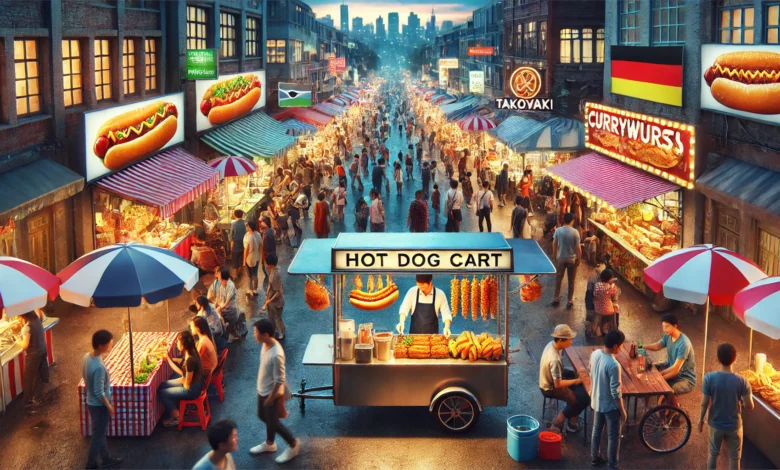Highway Haute Cuisine Exploring the World of Road Food

Introduction
Road food, often synonymous with street food, has a storied history that spans centuries, evolving from humble beginnings to a celebrated culinary genre. Originally, road food served as a quick, economical meal for workers and travelers who didn’t have time or means for a sit-down meal. Today, it encompasses an array of dishes integral to the cultural tapestry of societies worldwide. This article dives into the rich world of road food, exploring its evolution, cultural significance, and impact on communities, tourism, and the culinary arts.
The Evolution of Road Food
Road food has come a long way from its origins. In ancient times, street vendors in civilizations like Rome and China nourished city dwellers and visitors, offering everything from baked goods to hearty stews. As cities grew, these informal eateries became a staple of urban life, providing accessible meals to the bustling populace. In the modern era, globalization has played a significant role in diversifying road food menus worldwide, introducing people to flavors and techniques from distant lands. This cross-cultural exchange has transformed road food from simple sustenance into a vibrant part of global cuisine.
In the United States, road food has evolved into a symbol of regional pride, with dishes like New York’s hot dogs and San Francisco’s mission burritos reflecting local history and tastes. Similarly, in Europe, dishes such as Belgian frites and German currywurst represent traditional flavors adapted to the fast-paced environment of street vending. The transformation is also evident in Asia, where street food offers convenience and embodies complex flavors that testify to each country’s culinary heritage. In countries like Thailand and Vietnam, road food is central to daily life and offers an array of choices ranging from spicy soups to sweet treats.
Discovering Road Food: A Culinary Adventure

Exploring road food provides a direct line to the heart of a culture. In the United States, the diversity of road food mirrors the melting pot of its society. Classic American road foods such as hot dogs, hamburgers, and BBQ ribs speak to the nation’s love for hearty, flavorful meals that can be enjoyed on the go. These dishes are not just quick bites but are part of the fabric of American festivities and gatherings.
Across the Atlantic, Europe offers a variety of road food. The UK’s fish and chips, wrapped in paper and enjoyed on a windy pier, are as iconic as delicious. Germany’s currywurst, smothered in ketchup and curry powder, is a testament to post-war innovation in cuisine. Each European country has its version of road food, reflecting its unique cultural and culinary history.
Asia’s road food scene is the most dynamic and varied. From India’s pani puri, a burst of tangy tamarind water in a crisp shell, to Japan’s takoyaki, octopus-filled dough balls drizzled with mayo and sauce, the flavors are intense and diverse. These foods are a feast for the taste buds and provide insight into the region’sregions’ culinary arts. The hustle and bustle around Asia’s street food stalls are as much a part of the experience as the eating itself, offering a slice of daily life in vibrant and vivid detail.
The Social and Economic Impact of Road Food
The impact of road food extends beyond mere consumption; it is a vital economic and social catalyst. For many communities, especially in developing countries, road food provides essential economic opportunities, supporting many families and fueling local economies. Vendors are often small operators for whom the low barrier to entry makes road food a viable business venture.
Socially, road food has the power to bring people together, offering a communal space where all levels of society can mingle over a love of food. These food hubs become vibrant social centers in many places, buzzing with activity and chatter long into the night. Furthermore, for tourists, road food is a gateway to authentic cultural experiences, providing direct access to local flavors and traditions in a way that restaurants often cannot replicate.
Conclusion
Road food is more than just a quick meal; it is an enduring element of humanity’s gastronomic heritage. From ancient marketplaces to modern food trucks, the evolution of road food reflects the dynamic nature of human societies. It is a culinary tradition that celebrates flavor, community, culture, and innovation. As we continue to explore and enjoy the world’s highways and byways, let us embrace the rich tapestry of road food with appreciation and respect for its ability to unite and nourish us in many ways.
FAQs
What is considered road food?
Road food refers to meals prepared quickly and eaten on the go, typically sold by street vendors or at markets.
How do I find the best road food in a new city?
Look for high foot traffic areas, check online reviews, and ask locals for recommendations to discover popular spots.
Are there vegetarian or vegan road food options?
Many cultures offer vegetarian and vegan road foods, ranging from Indian chaat to American grilled cheese.
How can I tell if a road food vendor is safe and hygienic?
Check for vendors with high turnover, clean serving areas, and good food handling practices.
Can road food be part of a healthy diet?
While road food is often indulgent, many vendors offer fresh, balanced meals that can fit into a healthy diet.
What are the must-try road foods around the world?
Some must-tries include Mexico’s tacos, India’s vada pav, and Thailand’s pad Thai.





